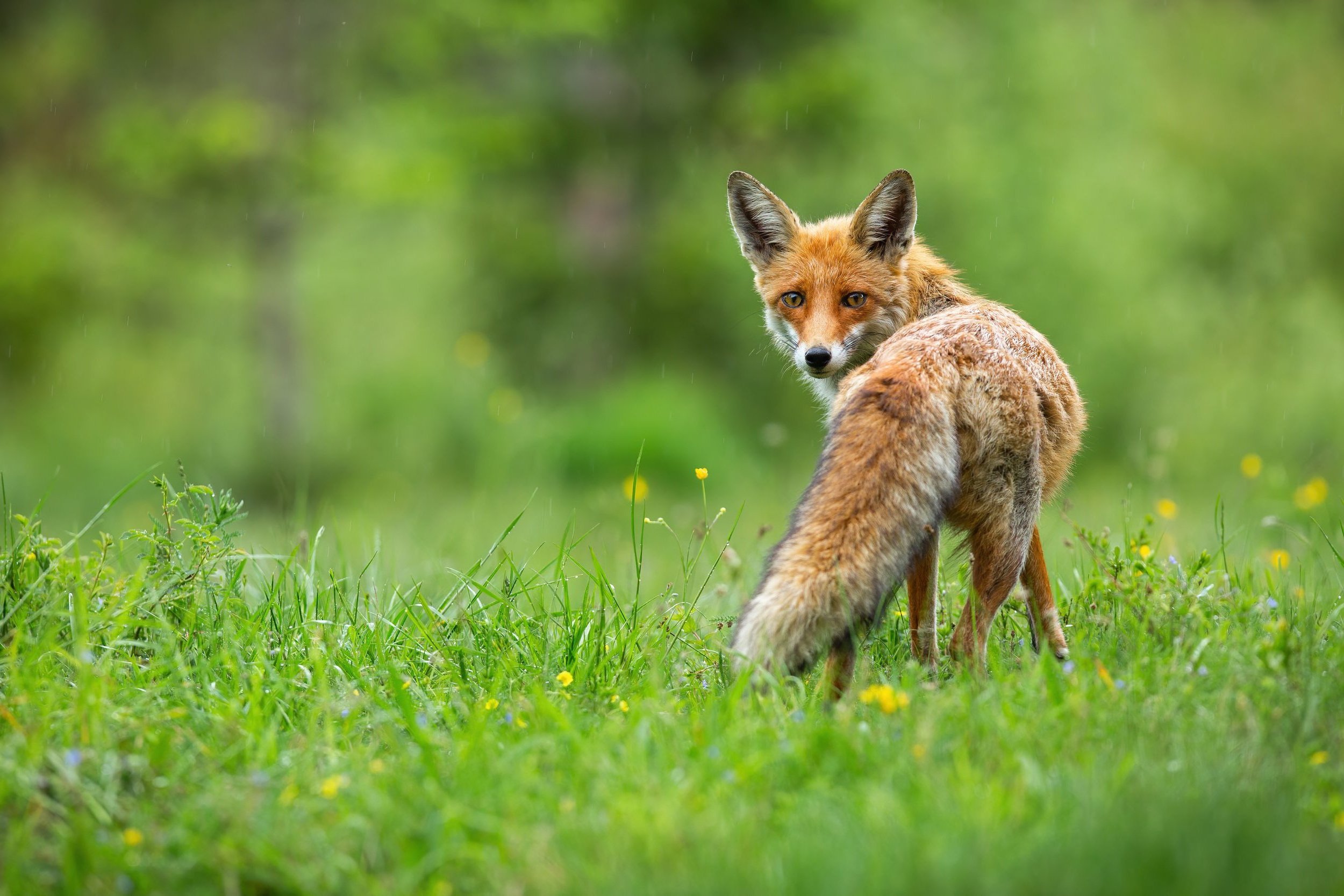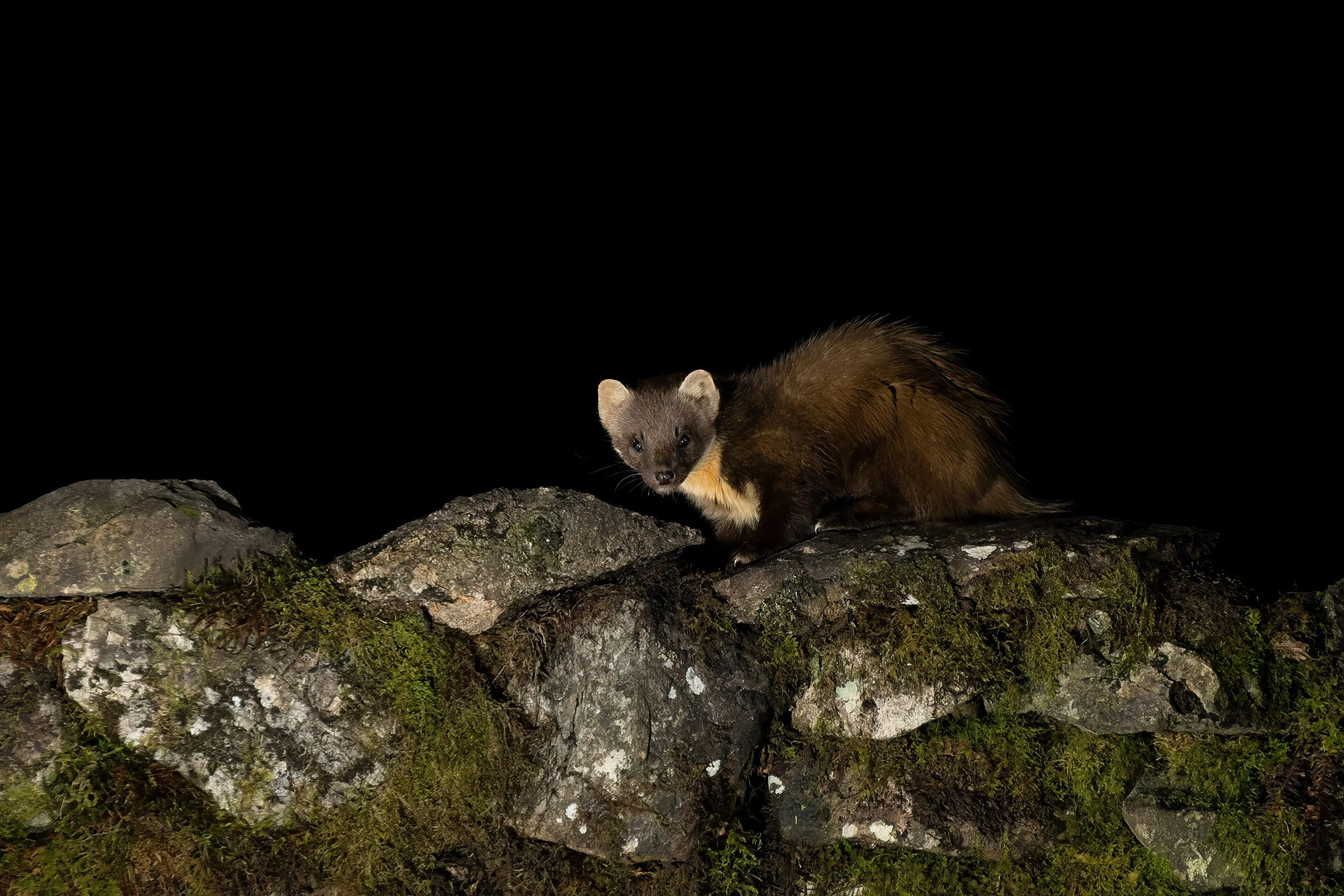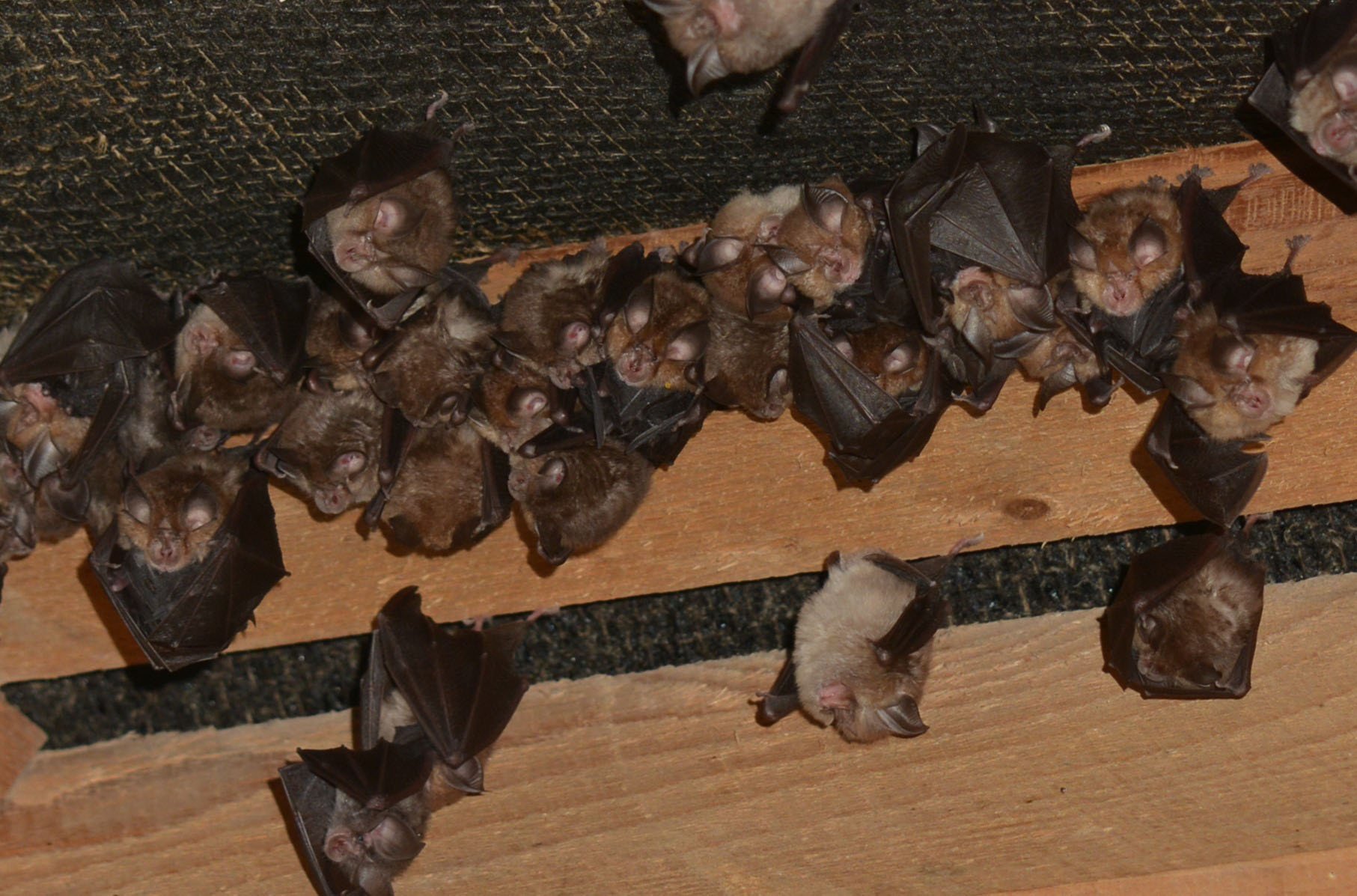Nocturnal wildlife of Iveragh
Although darkness can be a time when humans feel nervous to be out and about, it is the perfect time for many animals to hunt, feed, or travel. Here are some of the animals of Iveragh for whom darkness is essential.
Shearwaters / Cánóg
This photo was taken on Bardsey Island / Ynys Enlli in Wales. Manx shearwaters are vulnerable on land so they only return to their nests at night.
As the name suggests, shearwaters fly close to the surface of the ocean. The Manx shearwater has all black upperparts and reveals its white underparts when it gracefully changes direction in the air, rolling and banking above the waves, its wingtips seemingly inches from the water. These birds spend most of their lives far off the coast of South America, but many arrive under the cover of darkness to Skellig Michael and other islands each spring to breed. They nest in burrows or crevices, calling in strange crooning and cooing voices to each other – a sound that must have been familiar to the monks of the Skelligs.
As graceful as they are in flight, they are quite the opposite on land. Their legs are set far back on their body, ideal for the skies but it makes them slow and ungainly on the ground. They avoid gulls and other predators by only returning to their nests at night. They are also less active during the light of a full moon, landing and calling less frequently. Their chicks are born in dark burrows and are very vulnerable when they first emerge from these homes.
Shearwaters can be confused by artificial light, sometimes flying towards towns and villages rather than out to sea. It is common for these birds to ‘crash land’ around coastal dwellings, putting them at risk of injury or death by vehicles or predators. Dimming, reducing, or turning off artificial lights can really help shearwaters, especially during the summer months when fledglings are leaving their nests. You can find advice here if you find a grounded shearwater.
Frogs & Natterjack Toads
/
Frog & Cnádáin
Natterjack toads (cnádáin) are Ireland’s only native toad and they are extremely rare in Ireland. They call and breed in darkness.
Our common frogs go unnoticed for much of the year but the first clump of frogspawn is a sure sign that spring is just around the corner. Frogs stay hidden in moist bogs or leaf litter in woodlands where they hunt for spiders, worms and flies that cross their paths. Early in the new year, when the air becomes milder, frogs move towards mating ponds after dark. Their gentle croaking sounds grow louder as more and more frogs gather. They do sometimes call during the day, but the still air of night-time is the best for enjoying this natural wonder. Almost as quick as it all begins, the ponds empty of frogs and clumps of spawn are all that remain. The adults disperse, perhaps returning for another bout of mating later in spring but many won’t return until the following year.
We are very fortunate that Ireland’s rarest amphibian can be found on Iveragh. The natterjack toad leads a secret life in sandy coastal burrows for most of the year but announce their presence in dramatic style come the breeding season in April/May. Their name comes from a raucous mating call that can be heard through the night up to a kilometre away. Natterjacks have a curious walking style compared to the hopping of frogs, and they strut their way to breeding pools late at night, when the air is milder in late spring. Rather than clumps of frogspawn, natterjacks create strings of spawn in shallow pools and ponds. They are one of our rarest species, so if you are lucky enough to come across some, please refrain from disturbing them in any way.
Owls / Ulchabhán
Long-eared owls and pure white barn owls are the most common owls on Iveragh.
Barn owls & long-eared owls are the two species you are most likely to encounter at night on Iveragh. They are difficult to see in the darkness but listen for their calls. The Irish name for a barn owl is ‘scréacóg reilige’ meaning ‘graveyard screecher’ because of their long, eerie call. They also make ‘snoring’ type sounds around their nests which are often in old trees, stone ruins, or farmyard buildings. They are sometimes called ‘farmer’s friends’ as they perform a great pest control service around our farmlands. Barn owls have specially adapted feathers which allows them to fly in silence, allowing them to sneak up on a tasty rat or mouse.
The ‘ears’ on a long-eared owl are actually feathers and are likely used for both camouflage and displaying to other birds. They are known to nest in conifer woodland where their streaked brown and cream feathers giving them excellent camouflage. You might catch a glimpse of their bright orange eyes as they gaze at you from a tree branch. They have excellent eyesight and hearing, senses that allow them hunt for rodents, frogs, and small birds under the cover of darkness.
Moths / Leamhan
Moths like this beautiful emerald moth fly at night and can be important pollinators, just like butterflies.
We have around 1,500 species of moths in Ireland and lots of them are found here on Iveragh. Some moths fly at night (nocturnal), some fly during the day (diurnal) while other fly at dawn and dusk (crepuscular). Being active at night means they avoid daylight predators and don’t compete for the same food as day flying moths. If you ever have the pleasure of a close look at a moth, you might be surprised at their beauty. What initially appears to be plain white can in fact be delicate lace-like patterns that glisten like jewels. Others have more varied colours or large eyespots which trick would-be predators into thinking they have encountered something fearsome.
Something else you might notice is that moths can be very furry. This fur helps keep them warm at night and it also traps and transports pollen from flower to flower. Yes, that’s right, moths are as important as butterflies and bees when it comes to pollinating our plant life. Moths can also have long, feathery antennae. These structures pick up scents from food sources but also pheromones from other moths. Pheromones are perfume-like plumes emitted by moths and convey messages such as when they are looking for a mate.
Fox / Madra rua
Foxes are skilled hunters and an important part of our wildlife.
Combine big ears, a super sense of smell, and eyes that can see in the dark and you have a very impressive animal. With their red coats, white chests, and famously bushy tails, foxes are extremely beautiful members of the canine family (related to wolves and our pet dogs) and are one of Ireland’s top predators. Their keen hearing and stealthy manoeuvres allow them to tiptoe gently through the woodland floor and pounce on a large beetle or rodent. Special structures in their eyes act like mirrors and reflect light back through the iris. This gives them excellent night vision.
Foxes can be very vocal, especially around the mating season between December and February. The males (known as dog foxes) are larger than the female (vixens) and barking or eerie cries are common means of communication between them. When you are out and about in the Dark Sky Reserve you might hear these strange calls on the wind at night. If you are lucky, you might just catch a glimpse of the fox that is making these wonderful sounds.
Pine Marten / Cat Crainn
The Irish name means ‘tree cat’ and they are secretive nocturnal animals.
Most of us have never seen a pine marten or are perhaps even unsure of what one looks like. Their Irish name is ‘an cat crainn’ meaning ‘tree cat’ so this might help you imagine what to look for. A very agile mammal about the size of a house cat, they are in the mustelid family which includes otters, stoats, and badgers. Their coat is a rich dark brown and the pattern of their cream bibs are unique and a way of identifying individual animals.
They have a very varied diet and will dine on fungi, berries, worms, birds and more. They gained the name ‘tree cat’ in Ireland as they are expert climbers. Their big paws and sharp claws allow them to leap up and down tree trunks with ease and their large tails act as a counterbalance to steady them even on the highest branches. Their sensitive whiskers and excellent sense of smell means they are well adapted to nocturnal life. A very shy animal, you will be one of a small few lucky people if you encounter this rare Irish mammal on Iveragh.
Hare / Giorria
Irish mountain hares are a native species that is common in our folklore.
While you might see a hare during the daytime, these animals are especially active at dawn and dusk but are well equipped to explore at night too. Their large eyes are set far apart on the sides of their head, giving them a wide field of vision to spot any danger approaching. Hares also have a heightened sense of small and leave scent trails for each other, an important form of communication which can be understood even in total darkness. Young hares, called leverets, are scentless. Leverets are very vulnerable when they are young, so they stay hidden in vegetation until they are old enough to keep up with mum. Being without a scent helps leverets hide from predators that might use smell to find their food.
Badgers / Broc
Badgers are at home in the mixed habitats of Iveragh and only emerge at night time.
Badgers are highly social animals that live with their clan group in an underground ‘sett’. They only emerge from their setts after dark to forage for food. They rely on their very sharp senses of smell and hearing. Their eyesight is adapted to low light, but they are quite short-sighted. Like other nocturnal animals, in Irish folklore, they are often ‘shape-shifters’ or people in disguise as an animal.
Badger cubs are born early in the year and don’t come above ground for about 4 months. After that, they sometimes stay with their mothers for many months.
The clan will defend their territory, which will always include a range of places to find food and shelter, and males can be quite territorial and aggressive against each other. Although Badgers are strong animals, they are usually quite shy as they quietly snuffle in the dark for food, such as berries, roots, worms, and insects.
Bats / Ialtóg
There are 9 different species of bat on Iveragh, including the very rare Lesser horseshoe bat, and all of them need darkness.
One of the best nocturnal animals to have around when you are exploring the Dark Sky Reserve is a bat. A tiny bat weighing the same as a Euro coin can eat a thousand midges a night, a very welcome friend if you want to avoid those itchy-bitey midges! Where birds have dominated the daytime sky, bats have made the night-time their realm. If you’d like to learn more bats, have a look at our bat article or watch this video.
Credit for the photograph of the badger to Katy’s Wildlife Rescues.









